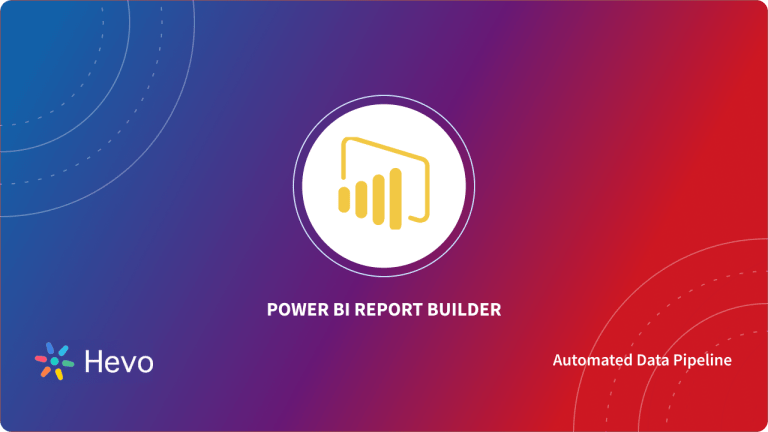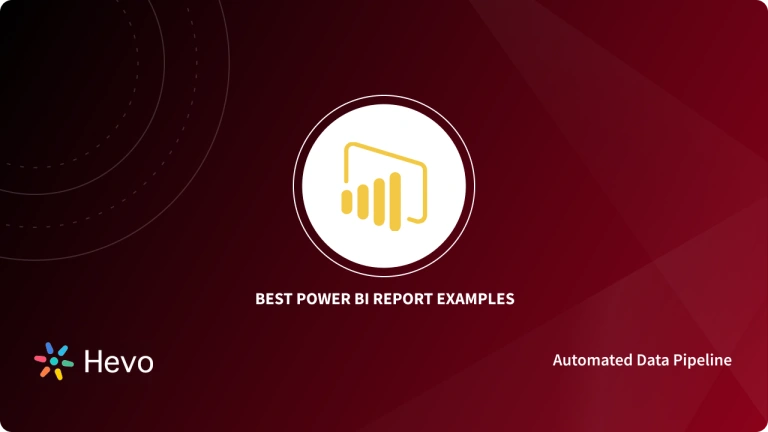One popular BI (Business Intelligence) tool that companies leverage to perform Data Visualization and build compelling dashboards & reports is Power BI. Power BI Report Design is a pivotal process that helps companies design accurate reports by unifying data from multiple sources and gain valuable insights from their customers.
Power BI Report Design can be performed in 2 simple methods. One is by connecting to their data sources on the Power BI Desktop and the other is by copying their data sources into Power BI directly on the web. As Power BI is part of the Microsoft Power Platform, it can easily integrate with other Microsoft technologies and constantly provide you with high-quality reports every step of the way.
In this article, you will understand the Power BI Report Design process in detail in 2 simple methods. A step-by-step procedure with images for both methods will help you understand the process easily. You will also get an overview of Power BI and the importance it holds for data-driven organizations. Read along to find out how you can leverage Power BI Report Design for your organization.
Table of Contents
What is Power BI?
Power BI is a Business Intelligence tool from Microsoft. It helps users to analyze data from various sources and build reports & dashboards. It can act as a stand-alone Desktop application or act as a completely managed Cloud-Based web service. While the Power BI Desktop comes as a free application, the Power BI Service is a paid offering based on subscriptions. Microsoft also offers Power BI Mobile for people who want to keep an eye on the data on the move. Power BI also offers Analytical capabilities that can be embedded into custom web applications. It integrates seamlessly with most of the enterprise Microsoft offerings.
Prerequisites
- A Power BI Desktop or Web Application account.
- Working knowledge of Power BI.
- Working knowledge of Databases and Data Sources.
Hevo simplifies data analytics by automating the process of extracting, transforming, and loading (ETL) data from multiple sources into cloud-based platforms for analysis. What Hevo Offers?
- Fully Managed: Hevo Data is a fully managed service and is straightforward to set up.
- Schema Management: Hevo Data automatically maps the source schema to perform analysis without worrying about the changing schema.
- Real-Time: Hevo Data works on the batch as well as real-time data transfer so that your data is analysis-ready always.
- Live Support: With 24/5 support, Hevo provides customer-centric solutions to the business use case.
What are the methods to create Power BI Report Design?
Power BI Report Design can be done using 2 simple methods. They are given below.
- Method 1: Creating Reports using the Power BI Desktop Tool
- Method 2: Creating Reports using the Power BI Web Tool
Method 1: Creating Reports using the Power BI Desktop Tool
In this method of Power BI Report Design, you need to ensure that you have Power BI Desktop installed on your system. The following steps can be followed to create reports using the Power BI Desktop Tool.
- Step 1: Integrating your Data Source with Power Query
- Step 2: Querying Data onto the Navigator
- Step 3: Editing the Queries on the Table
- Step 4: Shaping the Data According to your Requirements
- Step 5: Merging Queries from Different Tables
- Step 6: Loading the Report onto the Power BI Desktop
Step 1: Integrating your Data Source with Power Query
In this Power BI Report Design method, you will import your data and process it further using Power Query. You can connect to your data source by selecting the Home tab on the ribbon and then selecting Get Data > More as shown below.
In this example, you will learn the Power BI Report Design process by importing a Web data source. Select Get Data > Web. The Web data source dialog box appears. Paste the URL of the Web data source as shown below.
Step 2: Querying Data onto the Navigator
When you click on “OK”, the Query functionality of the Power BI Desktop tool starts the execution process and brings up the Navigator window. In this example, the Navigator finds a table and shows its preview.
Step 3: Editing the Queries on the Table
This method of Power BI Report Design also allows you to modify the queries before loading the table onto Power BI Desktop. If you want to do this select the “Transform Data” option on the bottom page. In case you want to load the data without editing, click on “Load”.
When you select Transform data, Power Query Editor starts, and a representative view of the table is shown. The Query Settings pane appears where you can connect to multiple data sources. This is shown below.
Step 4: Shaping the Data According to your Requirements
When you shape data in Power Query Editor, you provide step-by-step instructions to the editor to adjust the data as per your business requirements. The original data source isn’t affected. Only the data associated with this particular view will be adjusted or shaped.
The steps are carefully recorded under the Applied Steps section in the Power Query Settings Pane and the Power BI Desktop tool replicates the steps whenever the queries get executed.
The following image shows the Query Settings pane for a query that has been shaped.
An example of data shaping would be converting the data into a numeric format. In case you want to do this and change the data type, just right-click the column header, and then select Change Type > Whole Number.
In case you want to modify more than one column, select one of them, and then hold down the Shift key while you select additional adjacent columns. Then right-click a column header to change all the selected columns. You can also use the ctrl/command key to select non-adjacent columns. This is shown below.
Another way to change your data type would be to transform the columns from text to header by using the Transform tab, available on the ribbon.
This method of Power BI Report Design also allows you to edit any steps in the shaping process. In case you want to remove any data shaping step, you can go to the Applied Steps list in the Query Settings pane and select the step you want to remove, and click on the “X” button as shown below.
Step 5: Merging Queries from Different Tables
In this Power BI Report Design method, you can combine different tables from multiple data sources into a single table too. You need to import the table just like you saw in Step 2 and shape it if required.
To unify tables, you can merge the queries to make them easier for processing. To merge queries, you need to select the query you want to merge first. Next, select the query which will have this merged query. Then, click on the Home tab on the ribbon, and select “Merge Queries” as shown below.
Next, the Merge dialog box appears and you need to select the tables and columns to merge into the selected table. Once you select the tables you want to merge, click on the “OK” button as shown below.
Step 6: Loading the Report onto the Power BI Desktop
Now that the report is ready you need to load it onto the Power BI Desktop. You need to apply all the changes and save them. You can do this by replicating all changes in Power BI Desktop and selecting the “Close & Apply” on the Home tab on the ribbon.
Method 2: Creating Reports using the Power BI Web Tool
Unlike the Power BI Desktop Tool, the Power BI Web Tool enables you to directly import the data source onto Power BI on the web and automatically generate the report.
Power BI Report Design using this method can be done using the following steps:
- Step 1: Selecting your Data Source
- Step 2: Selecting the Data Types for Attributes
- Step 3: Summarizing your Data Source using Create Flow
- Step 4: Editing Fields using the Summarize Pane
Step 1: Selecting your Data Source
Once you open Power BI on the web, you need to go to the left navigation pane and click on the “Create” button. This helps you to choose your data source. This is shown below.
Currently, you can only paste data directly or choose data from an Excel file.
When you choose to type or paste data, you’ll get a grid that you can start to type into or paste with Ctrl-V on the context menu as shown below.
Step 2: Selecting the Data Types for Attributes
In this Power BI Report Design method, Power BI will automatically detect the data types, but you have the option to manually set them using the data type button to the left of the column name.
Step 3: Summarizing your Data Source using Create Flow
The Power BI Web Tool enables you to create a new data set and automatically generates a summarized version of the data using Create Flow. This helps you transform raw data into valuable insights within a matter of a few clicks.
A summarized data source using Create Flow is shown below.
Step 4: Editing Fields using the Summarize Pane
In this Power BI Report Design method, you can make reports as per your needs by editing them easily. In case you want to edit your report by adding or deleting columns, you can do that easily using the Summarize Pane feature supported by Power BI. To do this, simply select and unselect the fields you want to update, what you want to measure and analyze by, and you’ll see charts automatically added or removed to show all combinations.
An example of this technique is shown below.
This Power BI Report Design also provides you the ability to summarize the fields differently. To do this, you can choose the metrics by going to the context menu of the field in the Summarize pane and switching them as shown below.
This Power BI Report Design method saves the report by default when you click on “Create” in Step 1. From there, you can share it just like any report and whenever a user with edit permissions opens the report, they will land right back on this quick edit page.
Conclusion
This article gave a step-by-step guide on Power BI Report Design using 2 simple methods. It also gave an introduction to Power BI and highlighted its importance for any organization. Overall, Power BI Report Design plays a pivotal role in Business Data Analysis as it generates interactive reports that help companies better understand their customer and business requirements. Whether you use the Power BI Desktop Tool or the Power BI Web Tool, you can rest assured that you will design high-quality reports only.
Want to give Hevo a try? Sign Up for a 14-day free trial and experience the feature-rich Hevo suite firsthand. You may also have a look at the amazing price, which will assist you in selecting the best plan for your requirements.
Share your experience of understanding the Power BI Report Design in the comments section below!
FAQs
1. How to Design a Good Power BI Report?
Focus on clarity and purpose. Define the audience, key metrics, and objectives. Use appropriate visuals, maintain a logical layout, and ensure data accuracy. Add interactivity with slicers and filters for a dynamic user experience.
2. How to Customize a Power BI Report?
Adjust themes, colors, and fonts to match branding. Use custom visuals for specific needs. Modify visual properties like axes, labels, and tooltips. Add calculated columns and measures for tailored insights.
3. How to Improve the Appearance of Power BI Reports?
Use consistent color schemes, spacing, and alignment. Avoid clutter by highlighting key data points. Incorporate white space for readability. Leverage grids for alignment and apply conditional formatting for better data emphasis.




